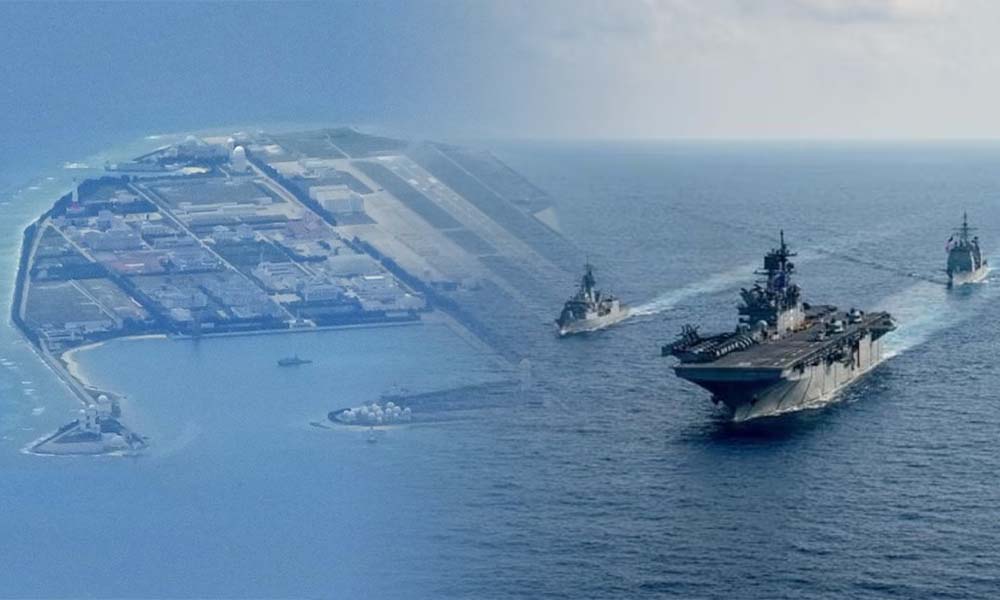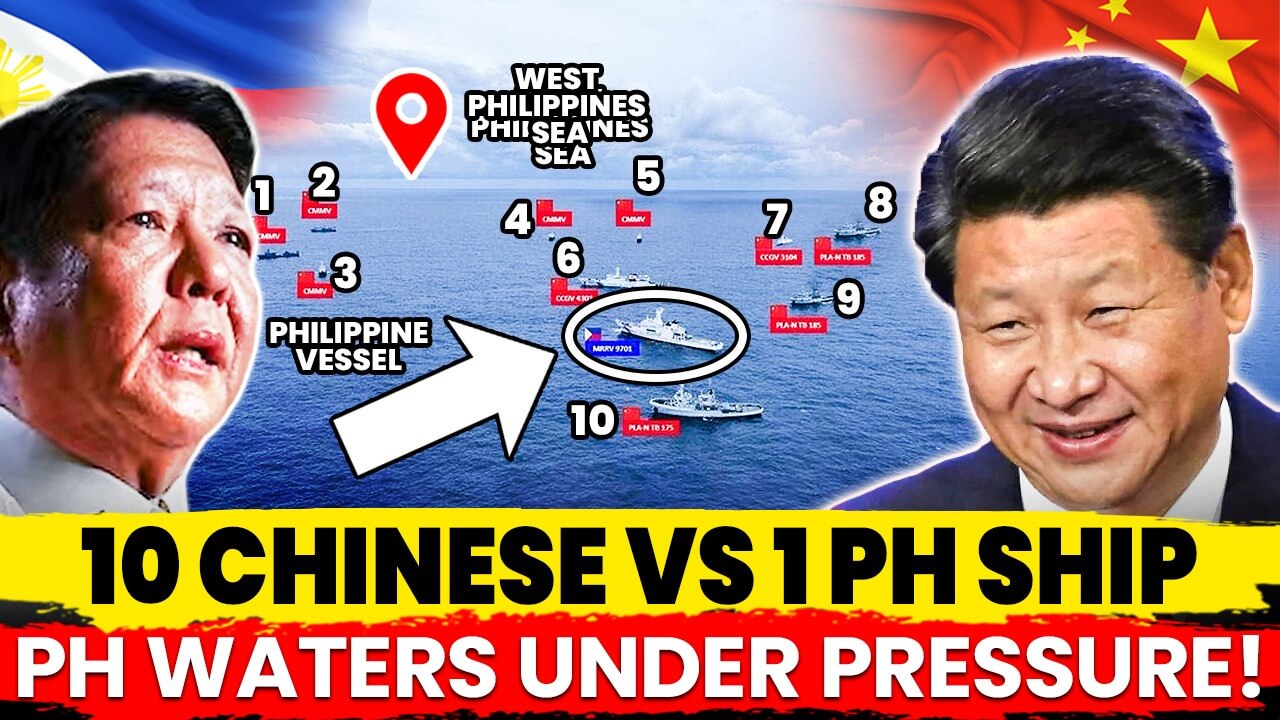Militarization of the South China Sea
The South China Sea has drawn the attention of global powers for decades. Given that this region lies at the heart of crucial global trade routes, this attention is unsurprising. Seventy to eighty percent of global trade activities take place via waterways. Of this, sixty percent of maritime shipments traverse through Asia, particularly the South China Sea.
To the east lies the vast Pacific Ocean, while the Indian Ocean, a significant trade hub, is to the south. Rich in hydrocarbon reserves and marine life, the South China Sea’s allure is evident. Estimates suggest that nearly twelve billion barrels of oil and 190 trillion cubic feet of natural gas are beneath its seabed. Add to this the sea’s global trade significance, and it’s clear why it is coveted by many global powers. Statistically, the South China Sea is the primary commercial route for one-third of maritime shipping, representing over three trillion dollars in trade. Underneath its waters, maritime life plays a critical role in the economies and diets of surrounding nations.
Economic Significance of the Sea
In studying regional disputes, one frequently encounters the term “Exclusive Economic Zones” (EEZ). Denoted in nautical miles, a country’s EEZ refers to territories under its legal jurisdiction as per international law. Several nations, including China, Taiwan, the Philippines, Japan, and South Korea, claim EEZs in the South China Sea, leading to overlapping territorial claims.
In 1982, the United Nations Convention on the Law of the Sea established a framework for all marine activities. This allows nations to claim EEZs up to 200 nautical miles from their coastlines. Within these zones, countries have exclusive rights over resources and maritime activities and can even control foreign access.
What Drives the Tensions in the South China Sea?
A primary source of tension in the South China Sea stems from differing adherence to the United Nations Convention on the Law of the Sea. While most countries in the region abide by this convention, China stands out with its unique nine-dashed line doctrine. This assertion, based on a historical claim, challenges the UN convention, intensifying friction among the neighboring countries. Encompassing roughly 80 percent of the South China Sea, this U-shaped line extends about 1800 km from China’s Hainan Island, overlapping with several sovereign territories. Consequently, it infringes upon numerous maritime zones and boundaries established by other nations.
China has further escalated matters by constructing artificial islands, equipping them with air bases, hospitals, administrative structures, and a variety of other facilities. Additionally, radio towers and monitoring stations have been established to oversee the surrounding regions. Despite these developments, China maintains that its infrastructural endeavors are not aimed at militarizing the islands. Notably, the Spratly Islands, Paracel Islands, and Scarborough Shoal are among the key areas with a significant Chinese military footprint.
The Significance of the Spratly Islands
Amidst the vast expanse of the ocean, lies the Spratly Archipelago, an assemblage of more than a hundred diminutive isles and atolls, encircled by bountiful aquatic domains and the potential reservoirs of oil and gas. Diverse nations, including the People’s Republic of China, Taiwan, and the Socialist Republic of Vietnam, assert their absolute sovereignty over this cluster of islands, while Malaysia and the Philippines assert their territorial rights over select portions of this maritime realm. Military contingents hailing from five of these sovereign entities, namely China, Malaysia, the Philippines, Taiwan, and Vietnam, have stationed their forces on approximately 45 of these insular formations. Additionally, Brunei views this area as its exclusive economic zone (EEZ).
Located strategically in the South China Sea, the Spratly Islands hold immense significance. Control over these islands translates to vast EEZs, granting the rights over the embedded resources. While all these nations have established minimal infrastructures on these islands, China’s presence is more pronounced. They’ve expanded several islands by adding sand, resulting in the establishment of three expansive military bases that span 3,000 acres. These bases are on the Fiery Cross, Mischief, and Subi Islands. Although China hasn’t stationed any air jets on these bases yet, the situation can shift in the foreseeable future. Notably, the airstrip on the Fiery Cross spans 3,110 meters over 670 acres. It’s remarkable to consider that this reef, which once had just two visible rocks, now stands as a testament to China’s extensive militarization efforts.
Paracel Islands
The Paracel Islands consist of about 130 small coral islands and reefs, situated approximately 220 miles (350 kilometers) southeast of China’s Hainan Island and roughly 250 miles (400 kilometers) east of central Vietnam. Historically, this region has been a flashpoint for military confrontations between China and Vietnam, with Taiwan also staking a claim. China has established a military base on these islands, notably on Woody Island. This air base is active, housing China’s J11 fighter jets. Almost 1,000 people reside on this island, predominantly Chinese military personnel. Periodic skirmishes in the sea between China and Vietnam have strained their bilateral relations.
Longstanding Conflict with the Philippines
In 2016, the Permanent Court of Arbitration ruled in favor of the Philippines on most of her submissions. The Philippines’ submission came from a violation of the United Nations Convention Law of the Sea when the Chinese tried to reclaim the Scarborough Shoal. The Permanent Court of Arbitration concluded there was “no legal basis for China to claim historic rights” over the nine-dash line since there was no proof that China has traditionally exercised exclusive control over the waters or resources. The panel criticized China’s land reclamation efforts and the creation of artificial islands in the Spratly Islands, claiming that these actions had severely harmed the coral reef environment. Additionally, it stated that Spratly Islands characteristics fall within the United Nations Convention Law of the Sea definition of “rocks” and are not eligible for a 200 nautical mile exclusive economic zone. However, China disregarded this ruling, calling it “ill-founded.” Taiwan did the same and rejected the Permanent Court of Arbitration’s ruling in 2019.
Washington’s Military Alliances
China’s actions in the region have prompted the US to collaborate with several Southeast Asian countries, including the Philippines and Vietnam, to counteract China’s influence. The US alleges that China has fortified the islands with weaponry such as anti-ship and anti-aircraft missiles, laser and jamming systems, and fighter aircraft, posing a considerable threat to neighboring nations. In response, the US has dispatched warships on what it terms “freedom of navigation operations.” The South China Sea is of strategic importance to the US, not only for trade from its western coast to the Indian Ocean and onward to the Middle East but also for military navigation. The US began amplifying its military footprint in the area in 2012, though it abstained from taking a stance in the territorial conflicts until recently. The US has conveyed its commitment to supporting the territorial rights of Southeast Asian countries in the South China Sea.
In the preceding decade, the nation of China has embarked on a trajectory of insular militarization, concurrently enhancing its naval prowess in a concerted effort to fortify its dominion within the South China Sea. This maritime augmentation, accompanied by cutting-edge technological advancements and the deployment of far-reaching missile systems, has elicited grave concerns from both the United States and the Association of Southeast Asian Nations. The substantial escalation of China’s naval capabilities may be construed as a proactive measure, seemingly aimed at preempting prospective challenges to its territorial integrity by the United States, with the overarching goal of sustaining a pivotal strategic advantage.
Air Identification Zone
China’s establishment of an Air Identification Zone mandates any aircraft traversing this area to obtain authorization from the People’s Republic of China. In response, the US has dispatched military aircraft to patrol this zone, aiming to counter China’s militarization and ensure adherence to international norms. This move by the US is perceived as a threat by China, prompting them to assert that the US should recognize their territorial boundaries and refrain from meddling in their affairs. Confrontations between the naval and air forces of both nations have become more frequent, occasionally resulting in tense standoffs.
In unity with the US, ASEAN nations have ramped up their defensive measures. The Philippines, for instance, has permitted the US to establish military bases on its territory and has been conducting joint military exercises with them. Strengthening its defense capabilities, the Philippines has acquired cruise missiles that can be equipped on warships. Similarly, Vietnam has fortified its arsenal with the purchase of Brahmas missiles from India. A bold move was made by the Philippines when they undertook an operation to dismantle a floating barrier set up by the Chinese Coast Guard in the southeastern shoal.
The South China Sea holds significance for all nations in the vicinity, each presenting legal entitlements over it. China remains steadfast in its historical claim, emphasizing the strategic value of the islands. With the US amplifying its presence in the region and forming alliances with nations like the Philippines and Vietnam, the dynamics appear precarious. The potential for conflict escalates as China shows no inclination to abide by the UNCLOS and respect the exclusive economic zones of its neighbors. As each nation seeks to assert its dominance, whether through naval or aerial means, the situation becomes increasingly intricate and volatile.
Why does the South China Sea matter to China?
China’s economic foundation is deeply intertwined with the South China Sea. A significant 60% of its trade navigates these waters, making the region pivotal for China’s economic stability. Through the years, China has strategically employed incremental tactics to strengthen its hold over the area. In today’s world, national security transcends mere territorial boundaries. Hence, exerting dominance over this sea enhances China’s influence over neighboring economies and beyond.
Conclusion:
The South China Sea, pulsating with geopolitical, economic, and strategic significance, has been a focal point of international attention for decades. Positioned as a crucible for global trade, its waters have seen an escalation of territorial disputes, militarization, and diplomatic tensions. Central to many nations, especially China, it represents not just an economic lifeline but also a symbol of national pride and strategic dominance.
China’s assertive actions, combined with its dismissal of international rulings and the establishment of the Air Identification Zone, showcases the nation’s intent to preserve its interests at any cost. Simultaneously, the involvement of the US and its strengthening alliances with Southeast Asian countries underline the broader global implications of the territorial disagreements in the region.
The extensive resource wealth inherent in the South China Sea, coupled with its substantial economic and strategic significance, unequivocally cements its status as a perpetual epicenter within the global stage. With nations in the vicinity and beyond assertively asserting their claims and demonstrating military prowess, the imperative of sustaining open diplomatic avenues for nurturing dialogue and collaboration cannot be overstated. The forthcoming trajectory of the South China Sea transcends mere territorial assertions or military preeminence; it is fundamentally rooted in safeguarding regional equilibrium, cultivating mutual confidence, and upholding the sanctity of international statutes and accords. Only with a collective commitment to peace and collaboration can potential conflicts be averted, ensuring that this vital maritime region remains a hub of global trade and cooperation, rather than a flashpoint of global tensions.



